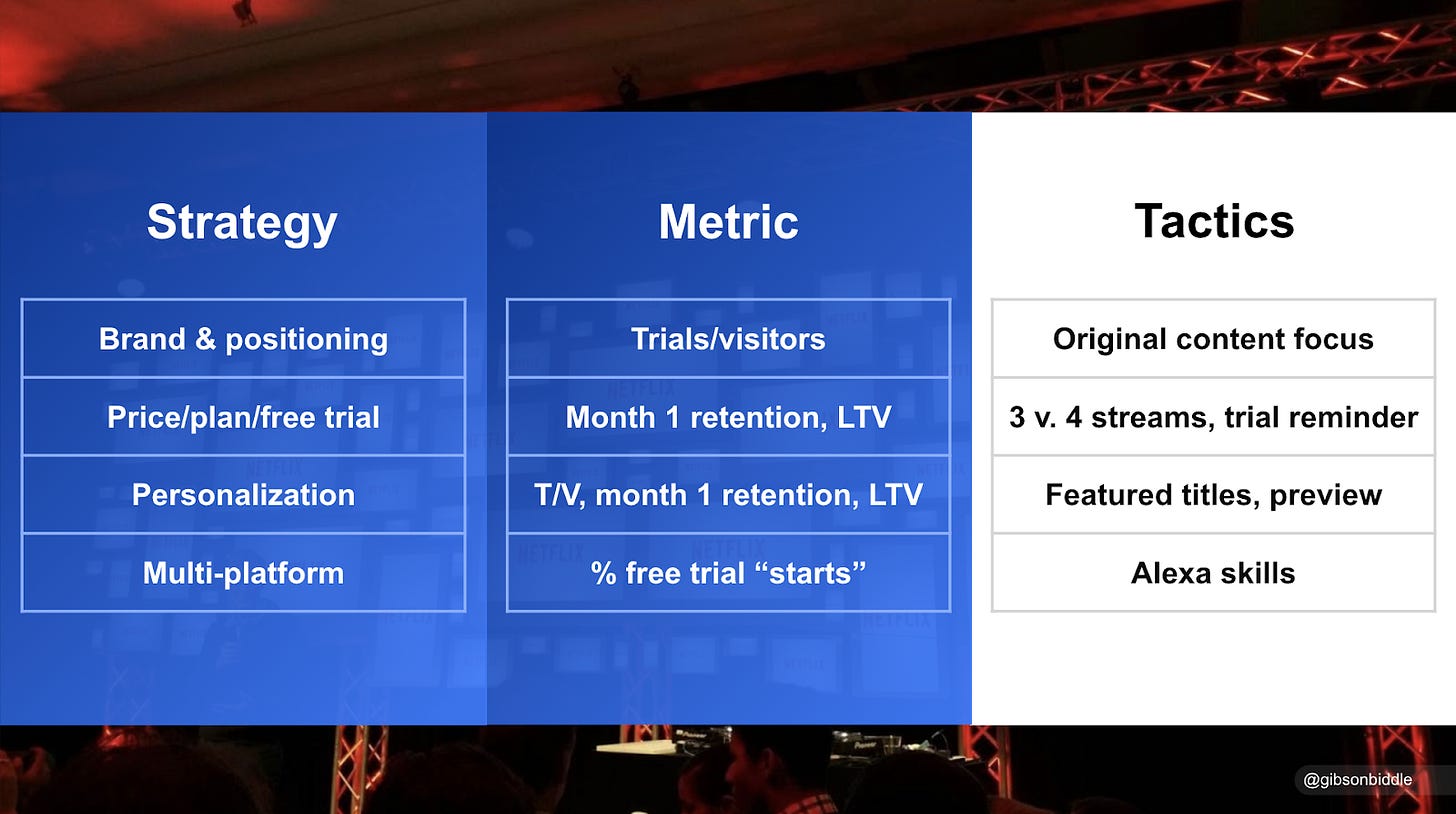How do you build up skills in product strategy?
Short answer: Through practice. Learn to apply the Strategy/Metric/Tactic framework to your product, no matter how small or large your product area is.
No matter what “level” of the company you inhabit or how small your project is, you can still articulate a product strategy. In simplest terms, a product strategy describes what metrics you will move, your high-level theories and hypotheses (your product strategies!) about how you will move these metrics, and the projects or tactics you will execute against each of these strategies.
A Sample Netflix Product Strategy
Here’s a highly simplified, fictional articulation of Netflix’s overall product strategy. At the highest level, the job is to improve member retention. (Today, only 2% of members cancel each month.) Below, I illustrate four high-level theories and hypotheses along with corresponding proxy metrics. The idea is if you move these proxy metrics, you will eventually improve your high-level metric — retention. In the right-hand column, I include potential projects against each strategy:
The SMT for a Netflix Swimlane
Each swimlane of a company can represent its product strategy using the same framework. (I call this the SMT framework.) For instance, think about the non-member swimlane for Netflix. This team's job is to build a “front door” that encourages non-members to sign up for a free, one-month trial. The high-level metric is Trials/Visits. (Today, 2% of folks who visit this page engage in a one-month free trial.)
This year, the non-member product team will likely engage 30-40 million new members. Below is a fictional SMT model for the swimlane with four high-level theories and hypotheses. The framework outlines how the team might improve conversion in 2021, along with proxy metrics for each strategy, plus sample tactics against each strategy:
The SMT framework provides a structure for thinking strategically, no matter how small your product area is. For your swimlane, what is the one high-level metric you will move? What product strategies will you employ to move this high-level metric? What proxy metrics will you use to measure whether these strategies are effective? Last, what projects will you launch against each of these strategies?
A sample SMT for my one-person company
You can use this SMT framework for anything. One of my strategies is to build awareness and trial for my paid services— my workshops and exec events. My high-level metric is engaged members, beginning with a topline number of non-paying customers, who eventually convert to paying customers.
Here’s the SMT model for just one of my high-level theories and hypotheses-- my efforts to build awareness and trial of my free and paid services:
Strategy:
Build awareness and trial for my services
Proxy metric:
The number of engaged free members, e.g., Twitter, LinkedIn, and Medium followers, plus email sign-ups; Today, I have 30K followers and 2,500 email sign-ups (I just started collecting emails!)
Projects or Tactics:
Free one-hour talks (80 talks in 2021)
Daily “Ask Gib” newsletter on Substack
Product Strategy, Career Hacking, and Culture essays on both Medium and LinkedIn
gibsonbiddle.com website enhancements and email capture (get special access to free test-drive talks and workshops)
Publish a Product Strategy book
My plan: If I drive my proxy metric -- engaged free customers— from 30K to 50K this year, it will be straightforward to support 40 paid talks, workshops, and exec events.
Practice Makes Perfect
How do you practice product strategy? Build an SMT framework for your swimlane or project. Be thoughtful about your high-level metric, what proxy metrics you use to validate each strategy, then assign corresponding tactics.
If you haven’t read my “How to Define Your Product Strategy” series on Medium, I think you will find it helpful. I go into greater depth and outline a step by step approach through a dozen three-minute essays. I even provide pre-formatted Google Slides at the end so you can outline your own product strategy. You can also sign up for my next product strategy workshop on February 9, 2021, at a European-friendly time.
If you want to ensure you never miss an answer, sign up for my newsletter below:
Best,
Gib
PS. Click here to give feedback on this essay. It only takes one minute.
PPS. Click the button below to ask and upvote more questions:





Hi Gib,
Thanks for this. I wonder if you can share some thoughts on how you go about coming up with the Projects or Tactics? To what degree are these insight driven, and if so what inputs do you look at?
Thanks for the series.